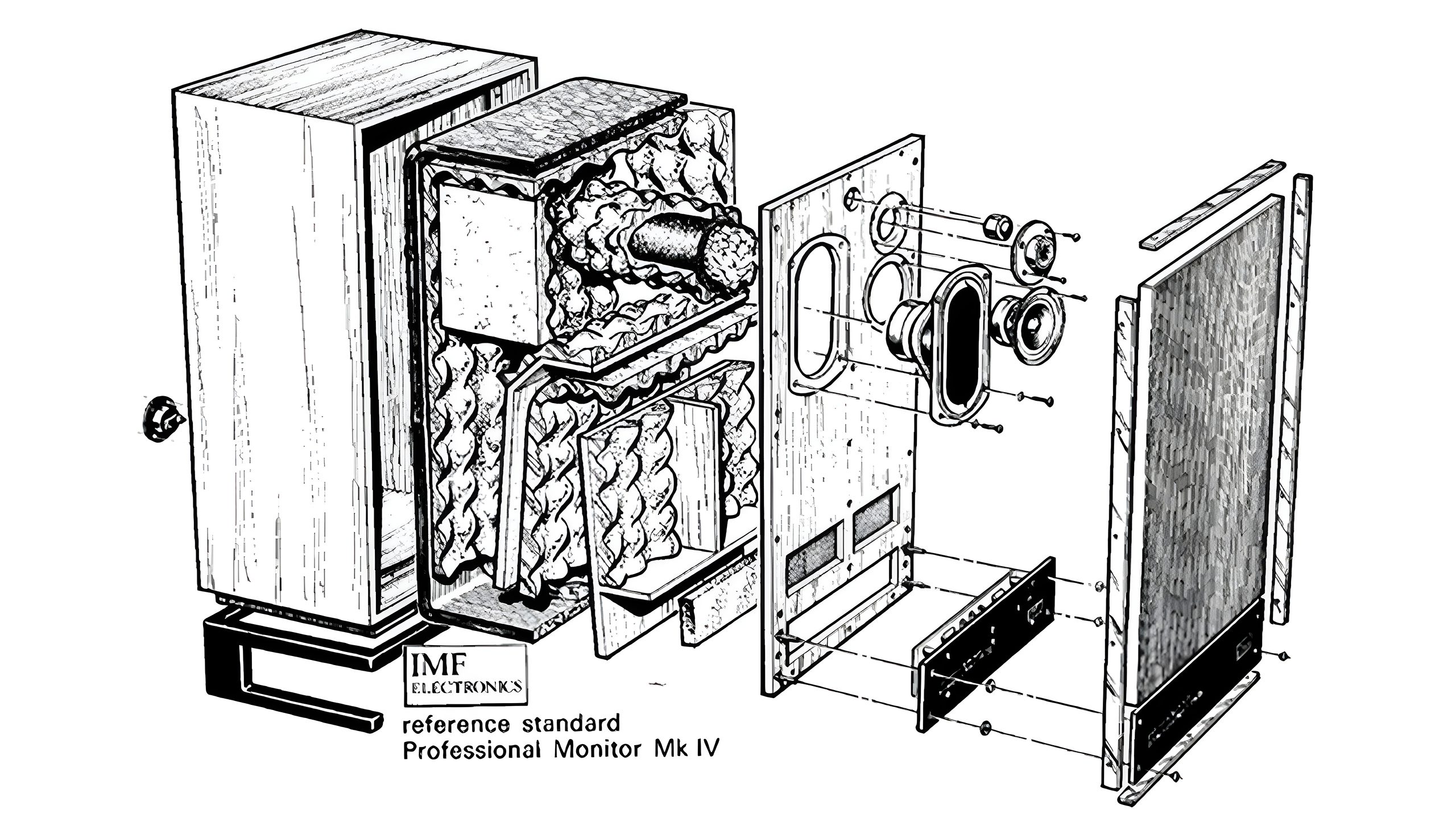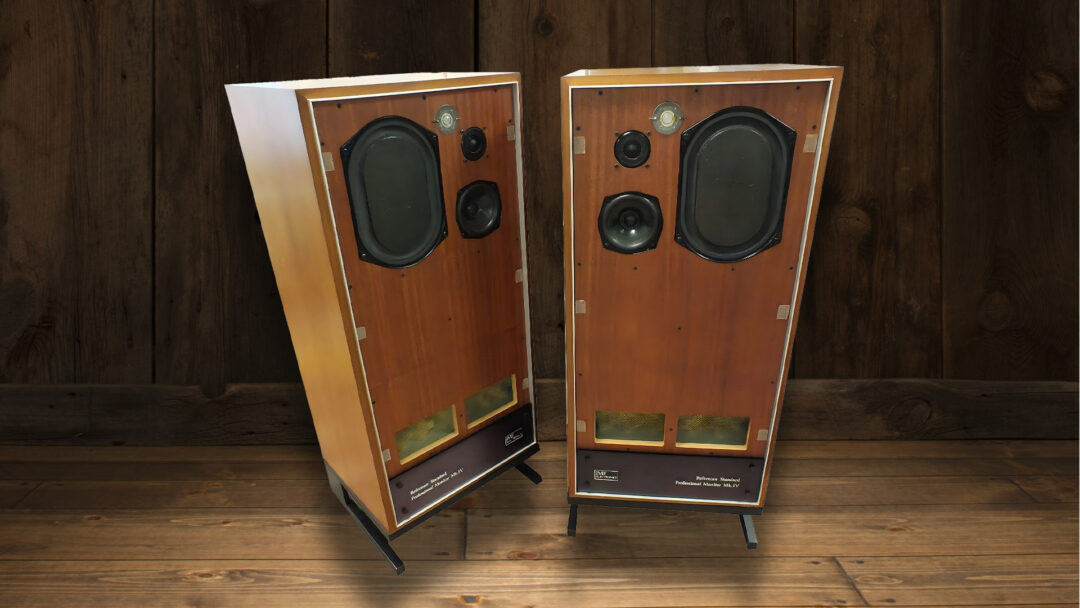IMF Reference Standard Professional Monitor MK IV.
The name is almost as imposing as the speakers. And in the 1970s and 80s, IMF was one of those brands that a young hi-fi enthusiast could only dream of. And nothing impressed more than when the heartbeat in the opening track of Pink Floyd’s Dark Side of the Moon was played on the metre-high four-way speakers. Such deep, powerful and, most importantly, clean bass had never been heard before.
The reference speakers were built according to an exotic principle called transmission line. The oval KEF B139 woofers were mounted at one end of a 2.5 metre long tunnel that meandered through the cabinet, eventually opening into two slots at the bottom of the front panel. The tunnel was lined with a mixture of foam rubber and sheep’s wool. And it was this construction that gave the speakers the unique bass response that made the jaws of teenage boys and hi-fi veterans alike drop.
JBL Paragon was the ultimate speaker to impress the neighbours in Beverly Hills in the 1950s and 60s. And it was in stereo!
The IMF Reference Standard Professional Monitor MK IV was a four-way loudspeaker. The upper bass and midrange was covered by a KEF B110 woofer with a polystyrene cone, which was also housed in a short transmission line. The treble was split between a KEF T27 dome and a Coles super tweeter. These were all good drivers, but it was the deep bass that made the IMFs stars.
Nuanced bass
In a bass reflex speaker, the port also adds to the deep bass, but the port only operates in a relatively narrow frequency range – typically less than an octave. At best, this means that the woofer still has to cover most of the bass range on its own. And at worst, it leads to “one note bass,” where the speaker plays lots of bass, but the sound is muddled.
In transmission line loudspeakers, the port provides a contribution over a much wider range, resulting in both more powerful and more nuanced bass, as not only very specific frequencies are boosted. And it is also possible to make a given woofer work deeper than in other types of cabinets, as the mass of the air column in the tunnel adds to the mass of the diaphragm and lowers the resonant frequency.

The IMF was not the first to design transmission line loudspeakers. The principle was described by A.R. Bailey back in 1965 in a construction article in Wireless World magazine. But the IMF was the first to commercialise transmission line loudspeakers. This was through a British-American collaboration, led by hi-fi importer Irwing M. Fried in New York. The loudspeakers were designed in England by a company named with Fried’s initials, IMF, and sold on the American market. But IMF was also available here in Europe. The flagship was the Reference Standard Professional Monitor, but there were smaller and cheaper models based on the same principle.
Success lasted about a decade. But the speakers were laborious and thus costly to build, and in the early 1980s Fried abandoned the transmission line in favour of more traditional speakers built under the Fried name. IMF Electronics of England changed their name to TDL Electronics, but continued to build transmission line loudspeakers throughout the 80s and 90s. The company still exists, but the current models are standard bass reflex speakers.
Without the commercialisation of this small loudspeaker, it would have remained a well-kept secret among BBC technicians.
Laborious principle
The costs of achieving the deep, accurate bass in a transmission line cabinet are several. Firstly, a several metre long folded tunnel means a large enclosure. The cabinet is complicated to build in terms of craftsmanship, and tuning the transmission line with precise amounts of damping material is also demanding. And finally, transmission line speakers tend to be extremely inefficient.
Wonderful, wasted watts
The latter is not really a fault of the principle, but a woofer that has to reproduce very low frequencies linearly needs either a very large diaphragm – which would mean an even more gigantic cabinet – or a very long excursion. And woofers with a long linear excursion must have a long voice coil, with only a small part of it in the voice coil gap, which in turn means that much of the amplifier power is wasted.
The KEF B139, which was used in many classic transmission line speakers, is a textbook example of this. And because it also has a relatively small magnet, a powerful amplifier is needed to drive the loudspeaker. The IMF Reference Standard Professional Monitor Mk IV is rated at a sensitivity of 80 dB! So forty watts are required to achieve a standard sound pressure level of 96 dB at a distance of one metre!
Speaker genius Stig Carlsson had revolutionary ideas - and created a bestseller.
Modern successors
For these reasons, the large, expensive and wickedly inefficient transmission line loudspeakers never achieved the widespread use to which they were sonically entitled. And the principle was – with a few exotic exceptions – largely forgotten for decades. Fortunately, thanks to more efficient drivers (and relaxed requirements for the very lowest octave), recent years have seen examples of new transmission line loudspeakers that are both smaller in size and less power hungry. Kerr Acoustics and PMC Twenty are examples of modern transmission line speakers.
Should I buy a set?
Although it’s been four decades since they went out of production, the IMF Reference Standard Professional Monitor MK IV is not impossible to get hold of. The speakers were sold in fairly large numbers in radio shops, so there are still many in circulation. A set in reasonable condition can be found for between €1,000 and €2,000. And if you can make do with the home version, the TLS-80, you may be lucky enough to get them for about half that. This allows for high-quality reproduction at a really reasonable price.
Be aware, however, that there may be unpleasant surprises hiding inside the cabinet. Neither foam nor sheep’s wool are everlasting materials, and if the damping material has shifted or deteriorated, it will drastically alter the reproduction.


The TDL loudspeakers that superseded IMF are also worth of consideration.
I own a pair of matched IMF speakers that are supposed to be placed with the logo on the outside for the left and right. They stand roughly 40″ tall and are about 19 inches wide and about that depth. Near the speaker banana connectors are two crossover switches with 3-4 possible positions. There are no model markings so I don’t know if they are TLS, Reference, Studio Reference or what. I don’t know how to safely remove the grill cloth to observe what the speaker design 3 way 4 way sizers or tweeter types. My old IMFSupercompacts had Beryllium dome tweeters… any help would be appreciated. I am located in NW New Jersey USA I need proper professional troubleshooting because the low end just dropped out suddenly and I was trying to get the best combination of the two switches per cabinet when this occurred.
1971, University Leeds starting my PhD. I had some spare cash. Local HiFi dealer demo’d a pair of Domestic Monitors. I took a Music Post Grad with me – Berlioz Symphony Phantasique was the HiFi demo track – my friend said “That is a Cello not a loudspeaker”. I sold my soul and bought a pair of Domestics. My wife was not impressed – we divorced later. Some things are important. Then I discovered Quad ESL – for a while I used the B139 section as a sub for my ESL 57s (Oh a stacked pair). Eventually my room filled up with HiFi stuff. I decluttered. The IMFs went to my friend who still enjoys them, my ESLs went to another friend who still uses them and now have ATC100ASL – active speakers. Made in Stroud – Love them. I did visit IMF in Maidenhead. They were into ambisonics with Michael Gerzon. They played me some ambisonic stuff, Conrad Johnson amps and IMF speakers – probably the best immersive sound ever.